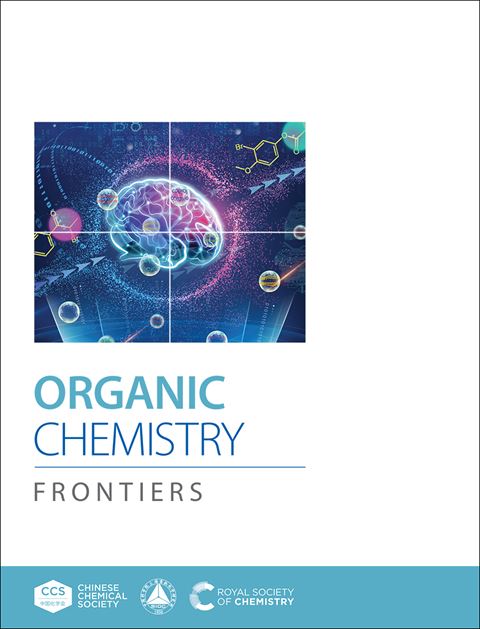硫代亚胺酸盐与萘酚的催化对映选择性歧化反应:构建含 N,S-缩醛的四代碳中心
IF 4.6
1区 化学
Q1 CHEMISTRY, ORGANIC
引用次数: 0
摘要
N, s -缩醛对映物分布于许多天然产物和药物中,具有广泛的生物活性。本研究通过环α-羰基硫代酸盐与萘酚之间的对映选择性发散反应,开辟了一条获取含N, s -缩醛的四取代碳立体中心的新途径。该反应以2-萘酚为亲核伙伴,通过外环C=O键的多米诺骨胶叠- friedel - crafts /O-半乙酰化反应,形成了结构多样的呋喃萘噻吩[b]衍生物,该衍生物具有两个相邻的含双杂原子的四取代碳立体中心,具有高光学纯度。相比之下,1-萘酚/富电子酚在环α-羰基硫代酸盐上的对映选择性加成可形成含N, s -缩醛的四取代碳立体中心,收率高,对映选择性好。DFT研究为反应机理和对映体选择性的起源,以及分别与2-萘酚和1-萘酚观察到的反应差异提供了有价值的见解。结果表明,萘酚类化合物与硫代酰亚胺类化合物加成过程中C-C键的形成是对映选择性的决定步骤,而C-H键的裂解是对映选择性的决定步骤。此外,从动力学和热力学上看,与2-萘酚的反应有利于随后的o -半乙酰化反应生成环化产物,而与1-萘酚的反应则有利于通过随后的质子化过程合成手性N, s -缩醛。本文章由计算机程序翻译,如有差异,请以英文原文为准。
Catalytic enantioselective divergent reaction of thioimidates with naphthols: construction of N,S-acetal-containing tetrasubstituted carbon centers
Enantiopure N,S-acetals are distributed in numerous natural products and pharmaceuticals, exhibiting a broad spectrum of biological activities. Herein we open a new avenue for accessing N,S-acetal-containing tetrasubstituted carbon stereogenic centers through an enantioselective divergent reaction between cyclic α-carbonyl thioimidates and naphthols. Using 2-naphthols as nucleophilic partners, the reaction enabled the formation of structurally diverse furanonaphthobenzo[b]thiophene derivatives bearing two vicinal diheteroatom-containing tetrasubstituted carbon stereogenic centers with high optical purities through a domino aza-Friedel–Crafts/O-hemiacetalization of the exocyclic C=O bond. In contrast, the enantioselective addition of1-naphthols/electron-rich phenols to cyclic α-carbonyl thioimidates led to the formation of N,S-acetal-containing tetrasubstituted carbon stereogenic centers in high yields and excellent enantioselectivities. DFT studies provide valuable insights into the reaction mechanism and the origin of enantioselectivity, as well as the reaction divergence observed with 2-naphthols and 1-naphthols, respectively. The results suggest that the C–C bond formation during the addition of naphthols to thioimidates is the enantioselectivity-determining step, while the rate-determining step is the C–H bond cleavage. Additionally, both kinetically and thermodynamically, the reaction with 2-naphthols favors the subsequent O-hemiacetalization to yield cyclization products, whereas the addition of 1-naphthols to thiomidates is thermodynamically driven for the synthesis of chiral N,S-acetals through the subsequent protonation process.
求助全文
通过发布文献求助,成功后即可免费获取论文全文。
去求助
来源期刊

Organic Chemistry Frontiers
CHEMISTRY, ORGANIC-
CiteScore
7.90
自引率
11.10%
发文量
686
审稿时长
1 months
期刊介绍:
Organic Chemistry Frontiers is an esteemed journal that publishes high-quality research across the field of organic chemistry. It places a significant emphasis on studies that contribute substantially to the field by introducing new or significantly improved protocols and methodologies. The journal covers a wide array of topics which include, but are not limited to, organic synthesis, the development of synthetic methodologies, catalysis, natural products, functional organic materials, supramolecular and macromolecular chemistry, as well as physical and computational organic chemistry.
 求助内容:
求助内容: 应助结果提醒方式:
应助结果提醒方式:


